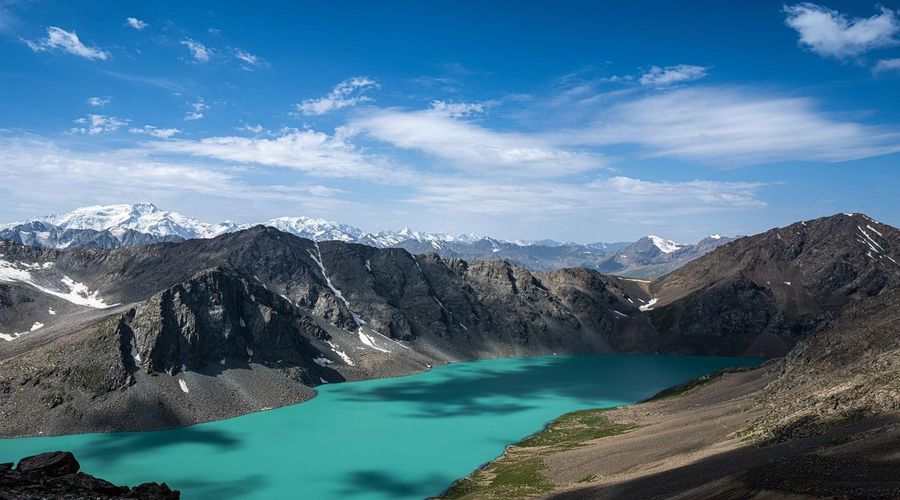Ala-Kul is a mesmerizing glacial lake in the Terskey Ala-Too mountain range within the broader Tian Shan mountain system in Kyrgyzstan, Central Asia.
The lake graces the landscape at a lofty elevation of approximately 11,680 feet above sea level.
Nestled between the Alakol Too and the Terskey Ala-Too mountain ranges, this high-altitude jewel contributes to its awe-inspiring scenery.
Spanning an area of about 1.5 km2, 2.8 km long, and 600–700 m wide, the lake is surrounded by rugged mountain peaks and pristine alpine meadows.
Its historical name, Ala-Köl, would literally translate to ‘variegated lake,’ although it likely derives its name from the Ala-Таu mountains situated farther north.
Read also: Chauvet Cave, the Oldest Decorated Cave with Paleolithic Artwork
Contents
Natural Formation and Best Time to Visit Ala-Kul Glacial Lake
The glacial lake of Ala-Kul forms through a fascinating natural process. As snow accumulates on the towering peaks surrounding the lake, it gradually transforms into ice over time.
The weight of this accumulated ice creates immense pressure, causing the ice to flow downhill as glaciers.
During warmer seasons, the heat from the sun triggers the melting of these glaciers, releasing vast quantities of water.
This meltwater gathers in depressions on the mountain slopes, eventually forming the lake.
The best time to visit the glacial lake phenomenon in Ala-Kul is during the summer months; particularly from June to September.
Alpine Splendor and Seasonal Changes
The Terskey Ala-Too region is renowned for its challenging yet rewarding trekking routes, with Ala-Kul standing as a prominent highlight.
Moreover, this area is characterized by a diverse range of ecosystems.
It includes coniferous forests at lower elevations, alpine meadows as the terrain ascends, and glacial landscapes nearer to the lake.
The region’s climate is influenced by its high altitude, featuring cool summers and cold winters
In comparison, summer unveils vibrant meadows, while winter blankets the landscape in snow, creating a wonderland.
The Ala-Kul Pass
The journey to Ala-Kul includes crossing the Ala-Kul Pass, a challenging yet rewarding segment of the trek.
At an elevation of around 12,664 feet, the pass opens up to breathtaking panoramic views.
Indeed, it provides a sense of accomplishment to those who conquer its heights.
The Trekking Path Through Kyrgyzstan’s Diverse Landscapes
Embarking on the trek to Ala-Kul offers adventurers an immersive experience, providing a thrilling opportunity to traverse Kyrgyzstan’s diverse landscapes.
The journey commences in the charming town of Karakol, guiding trekkers through alpine meadows, lush valleys, and dense forests.
Upon reaching Ala-Kul, trekkers can actively participate in camping by the shores of this majestic lake.
As the sun sets, people can actively bask in nature’s tranquil celestial display.
Additionally, this serene setting allows visitors to connect with the environment on a deeper level, creating unforgettable memories.
Nomadic Traditions Along the Ala-Kul
Kyrgyzstan’s nomadic traditions are revealed on the Ala-Kul trek, offering glimpses into local life.
As people from outside embark on this journey, they may encounter yurts, the traditional portable dwellings of the nomadic Kyrgyz people.
Moreover, they have the opportunity to interact with welcoming locals who share tales of their heritage.
Read also: Huaxi, the Richest Village in China with Collective Ownership
Ecosystems and Habitat for Wildlife
The varied ecosystems encountered during the trek showcase Kyrgyzstan’s rich biodiversity.
Furthermore, alpine flowers carpet the meadows, and keen-eyed observers might spot elusive wildlife such as marmots and golden eagles.
Additionally, the pristine surroundings contribute to the conservation of unique species that have adapted to the high-altitude environment.

